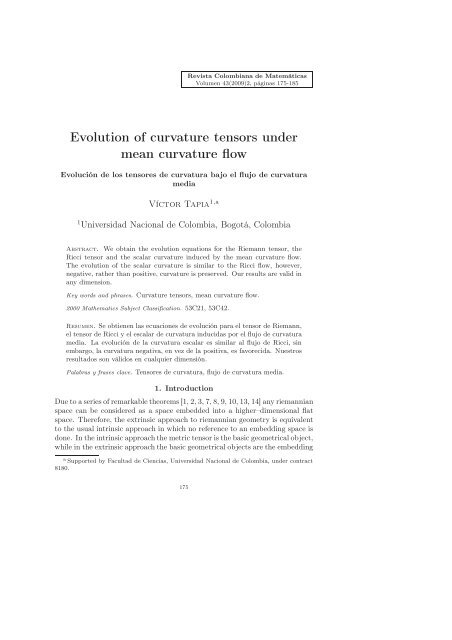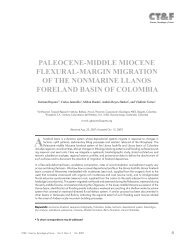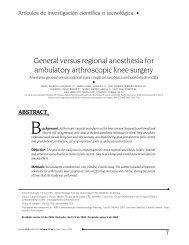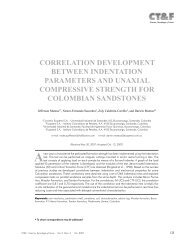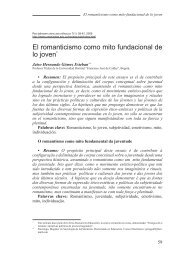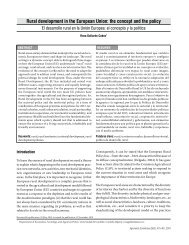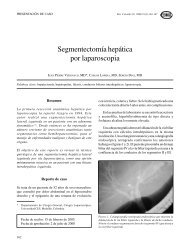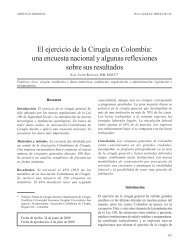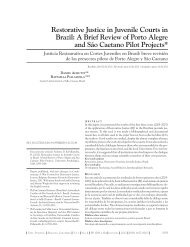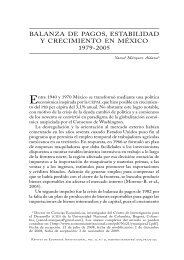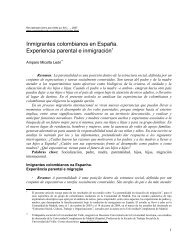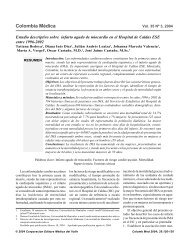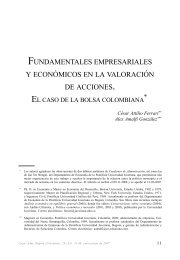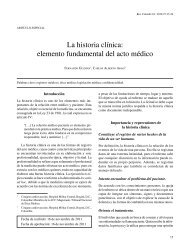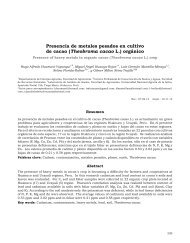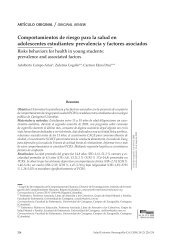Evolution of curvature tensors under mean curvature flow
Evolution of curvature tensors under mean curvature flow
Evolution of curvature tensors under mean curvature flow
You also want an ePaper? Increase the reach of your titles
YUMPU automatically turns print PDFs into web optimized ePapers that Google loves.
Revista Colombiana de Matemáticas<br />
Volumen 43(2009)2, páginas 175-185<br />
<strong>Evolution</strong> <strong>of</strong> <strong>curvature</strong> <strong>tensors</strong> <strong>under</strong><br />
<strong>mean</strong> <strong>curvature</strong> <strong>flow</strong><br />
Evolución de los tensores de curvatura bajo el flujo de curvatura<br />
media<br />
Víctor Tapia 1,a<br />
1 Universidad Nacional de Colombia, Bogotá, Colombia<br />
Abstract. We obtain the evolution equations for the Riemann tensor, the<br />
Ricci tensor and the scalar <strong>curvature</strong> induced by the <strong>mean</strong> <strong>curvature</strong> <strong>flow</strong>.<br />
The evolution <strong>of</strong> the scalar <strong>curvature</strong> is similar to the Ricci <strong>flow</strong>, however,<br />
negative, rather than positive, <strong>curvature</strong> is preserved. Our results are valid in<br />
any dimension.<br />
Key words and phrases. Curvature <strong>tensors</strong>, <strong>mean</strong> <strong>curvature</strong> <strong>flow</strong>.<br />
2000 Mathematics Subject Classification. 53C21, 53C42.<br />
Resumen. Se obtienen las ecuaciones de evolución para el tensor de Riemann,<br />
el tensor de Ricci y el escalar de curvatura inducidas por el flujo de curvatura<br />
media. La evolución de la curvatura escalar es similar al flujo de Ricci, sin<br />
embargo, la curvatura negativa, en vez de la positiva, es favorecida. Nuestros<br />
resultados son válidos en cualquier dimensión.<br />
Palabras y frases clave. Tensores de curvatura, flujo de curvatura media.<br />
1. Introduction<br />
Due to a series <strong>of</strong> remarkable theorems [1, 2, 3, 7, 8, 9, 10, 13, 14] any riemannian<br />
space can be considered as a space embedded into a higher–dimensional flat<br />
space. Therefore, the extrinsic approach to riemannian geometry is equivalent<br />
to the usual intrinsic approach in which no reference to an embedding space is<br />
done. In the intrinsic approach the metric tensor is the basic geometrical object,<br />
while in the extrinsic approach the basic geometrical objects are the embedding<br />
8180.<br />
a Supported by Facultad de Ciencias, Universidad Nacional de Colombia, <strong>under</strong> contract<br />
175
176 VÍCTOR TAPIA<br />
functions describing the situation <strong>of</strong> the embedded space as a subspace <strong>of</strong> the<br />
ambient space.<br />
One <strong>of</strong> the most interesting problems in geometric analysis is the description<br />
<strong>of</strong> the evolution <strong>of</strong> riemannian spaces <strong>under</strong> particular <strong>flow</strong>s. The best<br />
known examples are the Ricci <strong>flow</strong> and the <strong>mean</strong> <strong>curvature</strong> <strong>flow</strong>. The Ricci<br />
<strong>flow</strong> [11] describes how a riemannian space evolves, when the initial data are<br />
close enough to that <strong>of</strong> a sphere, towards a highly symmetric, homogeneous,<br />
configuration. The Ricci <strong>flow</strong> was initially developed for three–dimensional<br />
spaces having in mind its application in the demostration <strong>of</strong> the Thurston geometrisation<br />
conjecture [20] and, consequently, the resolution <strong>of</strong> the Poincaré<br />
conjecture [15, 16, 17]. On the other hand, the <strong>mean</strong> <strong>curvature</strong> <strong>flow</strong> [12, 21]<br />
describes the evolution <strong>of</strong> surfaces embedded in a higher dimensional, possibly<br />
flat, space. The <strong>mean</strong> <strong>curvature</strong> <strong>flow</strong> was initially developed for n dimensional<br />
surfaces embedded in R n+1 , but it can be generalized to an ambient space <strong>of</strong><br />
any dimension N > n.<br />
The Ricci <strong>flow</strong> is based on intrinsic riemannian geometry but, in spite <strong>of</strong> the<br />
fact that the evolution <strong>of</strong> a riemannian space <strong>under</strong> the Ricci <strong>flow</strong> is described<br />
intrinsically, these riemannian spaces are <strong>of</strong>ten pictured as embedded spaces.<br />
On the other hand, the <strong>mean</strong> <strong>curvature</strong> <strong>flow</strong> is based on extrinsic riemannian<br />
geometry. In this case, due to the equivalence <strong>of</strong> both approaches to<br />
riemannian geometry, the elements <strong>of</strong> intrinsic riemannian geometry (metric<br />
tensor, Riemann tensor, Ricci tensor, scalar <strong>curvature</strong>) also evolve <strong>under</strong> the<br />
<strong>mean</strong> <strong>curvature</strong> <strong>flow</strong>. To obtain these evolution equations is the purpose <strong>of</strong><br />
this work. Our main result is that the scalar <strong>curvature</strong> evolves according to<br />
an equation similar to the Ricci <strong>flow</strong> and therefore has similar properties, that<br />
is, for adequate initial data, spaces evolve towards highly symmetric, homogeneous,<br />
configurations. The main difference with respect to the Ricci <strong>flow</strong><br />
is that, due to the presence <strong>of</strong> a minus sign, negative, rather than positive,<br />
<strong>curvature</strong> is preserved.<br />
Section 2 contains preliminaries for Riemannian geometry and geometric<br />
<strong>flow</strong>s. Section 3 contains our main results, namely, the evolution equations for<br />
the <strong>curvature</strong> <strong>tensors</strong>. Section 4 contains our conclusions.<br />
2.1. Riemannian geometry<br />
2. Preliminaries<br />
Let us start with some fundamentals <strong>of</strong> riemannian geometry [18]. The basic<br />
geometrical object in riemannian geometry is the metric tensor g with components<br />
g ij (x). The Christ<strong>of</strong>fel symbol is given by:<br />
Γ k ij = 1 [<br />
∂gjl<br />
2 gkl ∂x i + ∂g il<br />
∂x j − ∂g ]<br />
ij<br />
∂x l , (1)<br />
Volumen 43, Número 2, Año 2009
MEAN CURVATURA FLOW 177<br />
and the covariant derivative <strong>of</strong> a covariant vector is given by<br />
∇ i v j = ∂v j<br />
∂x i −Γk ij v k . (2)<br />
The covariant derivative extends in a natural way to contravariant vectors and<br />
<strong>tensors</strong> <strong>of</strong> any covariance so as to preserve the Leibniz rule. In particular<br />
The Riemann tensor is given by<br />
∇ k g ij ≡ 0. (3)<br />
R k lij = ∂Γk jl<br />
∂x i − ∂Γk il<br />
∂x j +Γ k imΓ m jl −Γ k jmΓ m il. (4)<br />
Covariant derivatives do not commute, and we obtain the Ricci identity for a<br />
covariant vector<br />
∇ i ∇ j v k −∇ j ∇ i v k = −R l kij v l . (5)<br />
The Ricci identity extends in a natural way to contravariant vectors and <strong>tensors</strong><br />
<strong>of</strong> any covariance.<br />
The completely covariant Riemann tensor, R ijkl = g im R m jkl, is given by<br />
R ijkl (g) = 1 [ ∂ 2 ]<br />
g jk<br />
2 ∂x i ∂x l + ∂2 g il<br />
∂x j ∂x k − ∂2 g jl<br />
∂x i ∂x k − ∂2 g ik<br />
∂x j ∂x l<br />
+g mn [Γ m ilΓ n jk −Γ m ikΓ n jl] . (6)<br />
The Ricci tensor and the scalar <strong>curvature</strong> are given by the usual expressions<br />
R jl (g) = g ik R ijkl (g), (7)<br />
R(g) = g jl R jl (g). (8)<br />
Finally, the completely covariant Riemann tensor (6) satisfies the Bianchi identity<br />
∇ i R jklm (g)+∇ j R kilm (g)+∇ k R ijlm (g) ≡ 0. (9)<br />
Now we remind some elementary results in extrinsic riemannian geometry<br />
[6]. Let V n be a riemannian space with metric tensorg with components g ij (x).<br />
According to the local and global embedding theorems [1, 2, 3, 7, 8, 9, 10, 13, 14]<br />
always there exist functions X A = X A (x), A = 1,··· ,N, and G AB , N ≥ n,<br />
with Rie(G) = 0, such that the components <strong>of</strong> the metric tensor g can be<br />
written as<br />
g ij = G AB X A iX B j, (10)<br />
whereX A i = ∂X A /∂x i . Therefore, any riemannian spaceV n can be considered<br />
as a space embedded in a higher–dimensional flat spaceE N , N ≥ n, with metric<br />
tensor G with components G AB in local coordinates X A . Then, g ij as given by<br />
Revista Colombiana de Matemáticas
178 VÍCTOR TAPIA<br />
(10) is the induced metric tensor. For later convenience we choose Minkowskian<br />
coordinates in E N such that G AB = η AB = diag(±1,··· ,±1). Denoting the<br />
coordinates X A by X we rewrite (10) as<br />
g ij = X i · X j , (11)<br />
where X i = ∂X/∂x i and the dot ‘·’ denotes the inner product with η AB .<br />
An important object in extrinsic riemannian geometry is the Gauss tensor,<br />
which is given by<br />
∇ ij X = X ij −Γ k ij X k , (12)<br />
where X ij = ∂ 2 X/∂x i ∂x j and ∇ ij = ∇ i ∇ j are second–order covariant derivatives.<br />
The Gauss tensor satisfies the important identity<br />
∇ ij X · ∇ k X ≡ 0, (13)<br />
where ∇ k X = X k . Identity (13) is used extensively in the rest <strong>of</strong> this work.<br />
The completely covariant Riemann tensor (6) is given by<br />
R ijkl = ∇ ik X · ∇ jl X−∇ il X · ∇ jk X. (14)<br />
This is the Gauss equation <strong>of</strong> the embedding.<br />
2.2. Geometric <strong>flow</strong>s<br />
In1982 Hamilton [11] introduced the Ricci <strong>flow</strong>, which is a differential equation<br />
generalizing some features <strong>of</strong> the heat equation for the components <strong>of</strong> a positive<br />
definite metric tensor. The Ricci <strong>flow</strong> is given by<br />
∂ t g ij = −2R ij (g). (15)<br />
Due to the minus sign, spaces are contracted in the direction <strong>of</strong> positive Ricci<br />
<strong>curvature</strong>, while are expanded in the direction <strong>of</strong> negative Ricci <strong>curvature</strong>. The<br />
scalar <strong>curvature</strong> evolves according to<br />
∂ t R = ∇ 2 R+2R ij R ij , (16)<br />
where ∇ 2 = g ij ∇ ij is the Laplacian and R ij R ij ≥ 0. When the initial data<br />
are close enough to that <strong>of</strong> a sphere, the Ricci <strong>flow</strong> makes a riemannian space<br />
to evolve towards stationary solutions which are constant <strong>curvature</strong> configurations.<br />
Furthermore, spaces with positive <strong>curvature</strong> keep on having positive<br />
<strong>curvature</strong>.<br />
The Ricci <strong>flow</strong> (16) was initially developed for a three–dimensional space<br />
having in mind its application in the demostration <strong>of</strong> the Thurston geometrisation<br />
conjecture [20] and, consequently, the resolution <strong>of</strong> the Poincaré conjecture<br />
[15, 16, 17]. In three dimensions several simplifications are possible, however,<br />
it must be observed that the Ricci <strong>flow</strong> can be defined in any dimension.<br />
Volumen 43, Número 2, Año 2009
MEAN CURVATURA FLOW 179<br />
One can also consider extrinsic <strong>flow</strong>s closer in spirit to what one has in<br />
mind when picturing evolving surfaces. In the extrinsic approach to riemannian<br />
geometry the basic geometrical objects are the embedding functions. Therefore,<br />
it would be natural to describe the evolution <strong>of</strong> embedded spaces in term <strong>of</strong><br />
these functions. In analogy with the heat equation <strong>of</strong> thermodynamics one<br />
considers the <strong>mean</strong> <strong>curvature</strong> <strong>flow</strong> [12, 21]<br />
∂ t X = ∇ 2 X, (17)<br />
where now the Laplacian is with respect to the induced metric tensorg as given<br />
by (11). The stationary solution <strong>of</strong> equation (17), ∂ t X = 0, is given by the<br />
condition ∇ 2 X = 0, which corresponds to minimal surfaces [5, 19].<br />
The <strong>mean</strong> <strong>curvature</strong> <strong>flow</strong> has been widely studied in the literature [12, 21].<br />
For example, the influence <strong>of</strong> the signature <strong>of</strong> the ambient space has been<br />
considered in [4]. However, our forthcoming analysis is new and different.<br />
In the first place, Huisken [12] considers only n–dimensional surfaces smoothly<br />
embedded inR n+1 . We are instead consideringn–dimensional spaces embedded<br />
in some R N , with N sufficiently large as to guarantee that the embedding<br />
theorems hold, locally and, if necessary, also globally. This is necessary because<br />
a smooth surface, which can be embedded locally in some R N , may develop<br />
singularities, and in this case a larger dimensionality would be necessary to<br />
guarantee that the global embedding theorems hold.<br />
3. <strong>Evolution</strong> <strong>of</strong> <strong>curvature</strong> <strong>tensors</strong><br />
The evolution <strong>of</strong> intrinsic quantities <strong>under</strong> the <strong>mean</strong> <strong>curvature</strong> <strong>flow</strong> is obtained<br />
just by combining (17) with the corresponding definitions, (11) and (14). For<br />
the metric tensor we obtain<br />
∂ t g ij = −2∇ 2 X · ∇ ij X. (18)<br />
This equation was considered by Huisken [12], but only in the case <strong>of</strong> an n–<br />
dimensional surface embedded in R n+1 , while we are considering the general<br />
case <strong>of</strong> an n dimensional surface embedded in R N with N large enough as to<br />
guarantee that the embedding theorems, local or global, as necessary, hold.<br />
Therefore, the evolution <strong>of</strong> the metric tensor is driven by the Gauss tensor<br />
(12). The stationary solutions <strong>of</strong> equation (18), ∂ t g ij = 0, are given by the<br />
condition ∇ 2 X · ∇ ij X = 0. Two possible solutions are: ∇ 2 X = 0 which<br />
corresponds to minimal surfaces as above, and ∇ ij X = 0, but this implies,<br />
according to (14), a flat space.<br />
Now we consider the evolution <strong>of</strong> the Riemann tensor, the Ricci tensor<br />
and the scalar <strong>curvature</strong>. The time derivative <strong>of</strong> the Riemann tensor can be<br />
written, using (6), completely in terms <strong>of</strong> derivatives <strong>of</strong> the metric tensor. Then,<br />
replacing from (18) we would obtain the evolution equation for the Riemann<br />
Revista Colombiana de Matemáticas
180 VÍCTOR TAPIA<br />
tensor induced by the <strong>mean</strong> <strong>curvature</strong> <strong>flow</strong>. However, we can also combine (12)<br />
and (17) which is the way in which we proceed now.<br />
The time derivative <strong>of</strong> the Gauss tensor is given by<br />
∂ t ∇ ij X = ∂ t<br />
(<br />
∂ij X−Γ k ij ∂ k X )<br />
= ∂ t ∂ ij X−Γ k ij ∂ t ∂ k X−∂ t Γ k ij ∂ k X<br />
= ∂ ij ∂ t X−Γ k ij ∂ k ∂ t X−∂ t Γ k ij ∂ k X<br />
= ∇ ij ∂ t X−∂ t Γ k ij ∂ k X<br />
= ∇ ij ∇ 2 X−∂ t Γ k ij ∂ k X. (19)<br />
The time derivative <strong>of</strong> the Riemann tensor is given by<br />
∂ t R ijkl = ∂ t ∇ ik X · ∇ jl X+∇ ik X · ∂ t ∇ jl X<br />
−∂ t ∇ il X · ∇ jk X−∇ il X · ∂ t ∇ jk X<br />
= ∇ ik ∇ 2 X · ∇ jl X+∇ ik X · ∇ jl ∇ 2 X<br />
−∇ il ∇ 2 X · ∇ jk X−∇ il X · ∇ jk ∇ 2 X. (20)<br />
where we have used (19) and the identity (13). We now attempt to write the<br />
right–hand side <strong>of</strong> equation (20) in terms <strong>of</strong> intrinsic geometrical objects. A<br />
look at equation (20) indicates that it is likely that its right–hand side contains<br />
terms involving second–order covariant derivatives <strong>of</strong> the Riemann and Ricci<br />
<strong>tensors</strong>.<br />
In order to proceed it is convenient to introduce a notation more adequate<br />
for indices manipulation. We write the expression above as<br />
∂ t R ijkl = ∇ ik•• X · ∇ jl X+∇ ik X · ∇ jl•• X<br />
−∇ il•• X · ∇ jk X−∇ il X · ∇ jk•• X, (21)<br />
where •• <strong>mean</strong>s that these two indices are contracted with the metric tensor;<br />
there is no ambiguity in this notation since the metric tensor and the covariant<br />
derivative commute, equation (3).<br />
Next we consider a series <strong>of</strong> identities which allow to interchange indices in<br />
several relevant expressions. The Ricci identity for ∇ k X, is given by<br />
∇ ijk X−∇ jik X = −R m kij ∇ m X. (22)<br />
Contracting this equation with ∇ ab X we obtain<br />
∇ ijk X · ∇ ab X−∇ jik X · ∇ ab X ≡ 0, (23)<br />
This relation allows to interchange indices in expressions <strong>of</strong> the type∇ 3 X·∇ 3 X;<br />
for example<br />
∇ abc X · ∇ ijk X = ∇ bac X · ∇ ijk X−R d cba∇ id X · ∇ jk X. (24)<br />
Volumen 43, Número 2, Año 2009
MEAN CURVATURA FLOW 181<br />
where we have used (13).<br />
The Bianchi identity for ∇ kl X is given by<br />
∇ ijkl X−∇ jikl X = −R m kij ∇ ml X−R m lij ∇ km X. (25)<br />
A similar equation is obtained by considering the covariant derivative <strong>of</strong> equation<br />
(22), namely<br />
∇ lijk X−∇ ljik X = −R m kij ∇ lm X−∇ l R m kij ∇ m X. (26)<br />
These last two expressions allow to interchange indices in expressions <strong>of</strong> the type<br />
∇ 4 X = ∇ klij X. Indices 3 and 4 can be interchanged without any difficulty,<br />
indices 2 and 3 can be interchanged using (26), and indices 1 and 2 can be<br />
interchanged using (25). For instance, we obtain<br />
∇ ••ik X = ∇ ik•• X<br />
+[R m i∇ km X+R m k∇ im X]−(R m k•i +R m i•k) ∇ •m X<br />
− 1 2 [∇ iR m ••k +∇ k R m ••i +∇ • (R m k•i +R m i•k)] ∇ m X. (27)<br />
In the previous expression we have taken care <strong>of</strong> keeping this expression symmetric<br />
in i and k. Contracting with ∇ jl X we obtain<br />
∇ ••ik X · ∇ jl X = ∇ ik•• X · ∇ jl X<br />
+R m k∇ im X · ∇ jl X+R m i∇ km X · ∇ jl X<br />
−R m k•i∇ m• X · ∇ jl X−R m i•k∇ m• X · ∇ jl X. (28)<br />
The right–hand side <strong>of</strong> equation (20) has the same symmetries as the Riemann<br />
tensor. The only terms, involving second–order covariant derivatives <strong>of</strong><br />
the Riemann and Ricci <strong>tensors</strong>, with the proper symmetries are<br />
A ijkl = ∇ 2 R ijkl ,<br />
B ijkl = ∇ •i R klj• −∇ •j R kli• +∇ •k R ijl• −∇ •l R ijk• ,<br />
C ijkl = ∇ ik R lj −∇ jk R li −∇ il R kj +∇ jl R ki<br />
+∇ ki R jl −∇ li R jk −∇ kj R il +∇ lj R ik . (29)<br />
However, using the Bianchi identity (9) and the Ricci identity (5) it can be<br />
shown that the second term coincides with the first one. Therefore, we can<br />
consider only the first and the third terms.<br />
Revista Colombiana de Matemáticas
182 VÍCTOR TAPIA<br />
The first term in (29) can be rewritten, using (28), as<br />
∇ 2 R ijkl = ∇ ik•• X · ∇ jl X+∇ jl•• X · ∇ ik X<br />
−∇ jk•• X · ∇ il X−∇ il•• X · ∇ jk X<br />
−R m k•i∇ m• X · ∇ jl X−R m i•k∇ m• X · ∇ jl X<br />
+R m k∇ im X · ∇ jl X+R m i∇ km X · ∇ jl X<br />
+R m k•j ∇ m• X · ∇ il X+R m j•k∇ m• X · ∇ il X<br />
−R m k∇ jm X · ∇ il X−R m j ∇ km X · ∇ il X<br />
+R m l•i∇ m• X · ∇ jk X+R m i•l∇ m• X · ∇ jk X<br />
−R m l∇ im X · ∇ jk X−R m i∇ lm X · ∇ jk X<br />
−R m l•j∇ m• X · ∇ ik X−R m j•l∇ m• X · ∇ ik X<br />
+R m l∇ jm X · ∇ ik X+R m j ∇ lm X · ∇ ik X<br />
+2∇ •ik X · ∇ •jl X−2∇ •jk X · ∇ •il X, (30)<br />
while the third term can be rewritten as<br />
∇ [i|[k R l]|j] = ∇ ik•• X · ∇ jl X+∇ jl•• X · ∇ ik X<br />
−∇ jk•• X · ∇ il X−∇ il•• X · ∇ jk X<br />
+4∇ •jl X · ∇ •ki X−4∇ •il X · ∇ •kj X<br />
−R m jlk∇ im X · ∇ •• X+R m ilk∇ jm X · ∇ •• X<br />
+R m jkl∇ im X · ∇ •• X−R m ikl∇ jm X · ∇ •• X<br />
−R m l•j ∇ •m X · ∇ ki X−R m k•i∇ •m X · ∇ lj X<br />
−R m i•k∇ jm X · ∇ •l X−R m j•l∇ im X · ∇ •k X<br />
+R m l•i∇ •m X · ∇ kj X+R m k•j ∇ •m X · ∇ li X<br />
+R m j•k∇ im X · ∇ •l X+R m i•l∇ jm X · ∇ •k X<br />
+R m k•j ∇ •m X · ∇ li X+R m l•i∇ •m X · ∇ kj X<br />
+R m i•l∇ jm X · ∇ •k X+R m j•k∇ im X · ∇ •l X<br />
−R m k•i∇ •m X · ∇ lj X−R m l•j∇ •m X · ∇ ki X<br />
−R m j•l∇ im X · ∇ •k X−R m i•k∇ jm X · ∇ •l X<br />
−R m jkl∇ im X · ∇ •• X+R m ikl∇ jm X · ∇ •• X<br />
−R m •kl∇ jm X · ∇ •i X+R m •kl∇ im X · ∇ •j X<br />
+R m •lk∇ jm X · ∇ •i X−R m •lk∇ im X · ∇ •j X. (31)<br />
Volumen 43, Número 2, Año 2009
MEAN CURVATURA FLOW 183<br />
Now, we can combine equations (21), (30) and (31) to eliminate all terms<br />
<strong>of</strong> the form ∇ 4 X·∇ 2 X and ∇ 3 X·∇ 3 X. The result is<br />
2∂ t R ijkl = 4∇ 2 R ijkl −[∇ ik R lj −∇ jk R li −∇ il R kj +∇ jl R ki<br />
+∇ ki R jl −∇ li R jk −∇ kj R il +∇ lj R ik ]<br />
−4 [R mjkl R m i +R imkl R m j +R ijml R m k +R ijkm R m l]<br />
+8R m k n iR mjnl −8R m k n j R minl +4R mn ij R mnkl<br />
+R m jkl∂ t g im −R m ikl∂ t g jm +R m lij ∂ t g km −R m kij ∂ t g lm . (32)<br />
The time derivatives <strong>of</strong> the Ricci tensor and <strong>of</strong> the scalar <strong>curvature</strong> are given<br />
by<br />
2∂ t R jl = 2∇ 2 R jl +2 [∇ mj R m l +∇ ml R m j]−2∇ jl R<br />
−8R mj R m l −4R mnpj R mnp l<br />
+[R m j ∂ t g lm +R m l∂ t g jm ] , (33)<br />
∂ t R = ∇ 2 R−4R ij R ij −2R ijkl R ijkl . (34)<br />
The last equation, (34), is similar to the Ricci <strong>flow</strong> (16), except for the presence<br />
<strong>of</strong> minus signs in the last terms. For positive definite metric <strong>tensors</strong> we have<br />
R ij R ij > 0 and R ijkl R ijkl > 0. Therefore, if we consider S = −R as our<br />
unknown function, then we have that negative, rather than positive, <strong>curvature</strong><br />
is preserved <strong>under</strong> this <strong>flow</strong>.<br />
Equation (34) can be rewritten in terms <strong>of</strong> extrinsic quantities using, for<br />
example, the Gauss equation (14). However, the resulting expression is not<br />
very illuminating, except for an embedding in R n+1 , which is the case which<br />
was considered by Huisken [12].<br />
Equations (32), (33) and (34) are valid in any dimension. However, for two<br />
and three dimensions the Riemann tensor acquires particularly simple forms<br />
and equation (34) reduces to<br />
In dimension n ≥ 4 we obtain<br />
[<br />
∂ t R (2) = ∇ 2 R (2) −4 R (2)] 2<br />
. (35)<br />
∂ t R (3) = ∇ 2 R (3) −12<br />
[Ric (3)] 2 [<br />
+2 R (3)] 2<br />
. (36)<br />
[Ric (n)] 2<br />
∂ t R (n) = ∇ 2 R (n) − 4n<br />
(n−2)<br />
4<br />
+<br />
[R (n)] 2 [<br />
−2 Weyl (n)] 2<br />
. (37)<br />
(n−2)(n−1)<br />
Revista Colombiana de Matemáticas
184 VÍCTOR TAPIA<br />
4. Conclusions<br />
The evolution induced by the <strong>mean</strong> <strong>curvature</strong> <strong>flow</strong> on the <strong>curvature</strong> tensor<br />
has several interesting properties. Firstly, all developments are valid for any<br />
dimension and for any signature. Secondly, for positive definite metric <strong>tensors</strong>,<br />
the evolution equation for the scalar <strong>curvature</strong>, (34), has the same generic<br />
properties as the Ricci <strong>flow</strong>. The evolution is towards constant <strong>curvature</strong> spaces<br />
and negative, rather than positive, <strong>curvature</strong> is preserved.<br />
Acknowledgements<br />
The author thanks Fernando Zalamea for inviting him to deliver a seminar on<br />
geometric analysis where the idea <strong>of</strong> this work was born. Some <strong>of</strong> the calculations<br />
were kindly and patiently checked by Alexander Torres. The author<br />
thanks Mikhail Malakhaltsev for useful criticism.<br />
References<br />
[1] C. Burstin, Ein beitrag zum problem der einbettung der riemannschen<br />
raume in euklidischen raumen, Rec. Math. Moscou (Math. Sbornik) 38<br />
(1931), 74–85 (ru).<br />
[2] E. Cartan, Sur la possibilité de plonger un espace riemannien donné dans<br />
un espace euclidien, Ann. Soc. Polon. Math. 6 (1927), 1–7 (fr).<br />
[3] C. J. Clarke, On the isometric global embedding <strong>of</strong> pseudo–riemannian<br />
manifolds, Proc. Roy. Soc. London A 314 (1970), 417–428.<br />
[4] K. Ecker, Interior estimates and longtime solutions for <strong>mean</strong> <strong>curvature</strong><br />
<strong>flow</strong> <strong>of</strong> noncompact spacelike hypersurfaces in minkowski space, J. Diff.<br />
Geom. 46 (1997), 481–498.<br />
[5] J. Eells and J. H. Sampson, Harmonic mappings <strong>of</strong> riemannian manifolds,<br />
Am. J. Math. 86 (1964), 109–160.<br />
[6] L. Eisenhart, Riemannian geometry, Princeton University Press, Princeton,<br />
1926.<br />
[7] A. Friedman, Local isometric embedding <strong>of</strong> riemannian manifolds with indefinite<br />
metric, J. Math. Mech. 10 (1961), 625–649.<br />
[8] R. E. Greene, Isometric embedding <strong>of</strong> riemannian and pseudo–riemannian<br />
manifolds, Memoirs Am. Math. Soc. 97 (1970), 1–63.<br />
[9] M. Gunther, On the perturbation problem associated to isometric embeddings<br />
<strong>of</strong> riemannian manifolds, Ann. Global Anal. Geom. 7 (1989), 69–77.<br />
[10] , Isometric embedding <strong>of</strong> riemannian manifolds, Proceedings <strong>of</strong> the<br />
International Congress <strong>of</strong> Mathematicians (Kyoto), 1990.<br />
Volumen 43, Número 2, Año 2009
MEAN CURVATURA FLOW 185<br />
[11] R. Hamilton, Three-manifolds with positive Ricci <strong>curvature</strong>, J. Diff. Geom.<br />
17 (1982), 255–306.<br />
[12] G. Huisken, Flow by <strong>mean</strong> <strong>curvature</strong> <strong>of</strong> convex surfaces into spheres, J.<br />
Diff. Geom. 20 (1984), 237–266.<br />
[13] M. Janet, Sur la possibilité du plonger un espace riemannien donné dans<br />
un espace euclidien, Ann. Soc. Pol. Math. 5 (1926), 38–43.<br />
[14] J. Nash, The imbedding problem for riemannian manifolds, Ann. Math.<br />
63 (1956), 20–63.<br />
[15] G. Perelman, The entropy formula for the ricci <strong>flow</strong> and its geometric<br />
applications, arXiv:math.DG/0211159, 2002.<br />
[16] , Finite extinction time for the solutions to the Ricci <strong>flow</strong> on certain<br />
three–manifolds, arXiv:math.DG/0307245, 2003.<br />
[17] , Ricci <strong>flow</strong> with surgery on three–manifolds,<br />
arXiv:math.DG/0303109, 2003.<br />
[18] J. A. Schouten, Ricci calculus, Springer, Berlin, 1954.<br />
[19] V. Tapia, The geometrical <strong>mean</strong>ing <strong>of</strong> the harmonic gauge for minimal<br />
surfaces, Nuovo Cimento B 103 (1989), 441–445.<br />
[20] W. P. Thurston, Three dimensional manifolds, kleinian groups and hyperbolic<br />
geometry, Bull. Am. Math. Soc. 6 (1982), 357–381.<br />
[21] M. T. Wang, Long–time existence and convergence <strong>of</strong> graphic <strong>mean</strong> <strong>curvature</strong><br />
<strong>flow</strong> in arbitrary dimension, Inv. Math. 148 (2002), 525–543.<br />
(Recibido en marzo de 2009. Aceptado en julio de 2009)<br />
Departamento de Matemáticas<br />
Universidad Nacional de Colombia<br />
Av. Ciudad de Quito, cll. 45<br />
Bogotá<br />
e-mail: tapiens@gmail.com<br />
Revista Colombiana de Matemáticas


